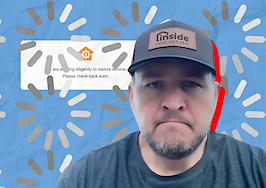With the pandemic restricting ability to conduct showings in some areas, it’s not a surprise agents are turning to virtual showings and property videos instead.
A lot of them have been asking about questions about the shooting process. Like, how to shoot effective videos that showcase the property in the best light possible. And what are some of the best camera equipment to use during this time. And how to edit those clips once they’re shot.
Since there are so many questions spinning in the heads of real estate agents, I reached out to Drew Appolonia via email. Appolonia is a video manager with BorrowLenses, so, in other words, he’s an expert when it comes to all things video and editing. Here are some of the insights he shared.
How is BorrowLenses helping the real estate industry during the COVID-19 pandemic?
Over the last few months, we’ve seen a ton of industries focus on creating content and deliver it right to potential customers’ inboxes as a way to shift resources and survive given the current circumstances. A prime example of one of those industries is real estate.
With fewer people able or willing to check out a house in person, the photos and videos representing a property need to make an immediate impact. And apparently, they are. Clients are happily embracing virtual tours, professional photos, and the wild card — real estate video, as long as they’re useful and engaging.
Why is real estate video the wild card?
Professional photos have been a must-have for a long time, and 3D tours are becoming increasingly popular as well. However, video has struggled to find a consistent foothold in the industry, because there are so many different ways you could shoot or capture a home. A lot of real estate professionals just aren’t sure where to start, but there are a lot of helpful resources out there for them.
What are the benefits of shooting a real estate video?
Before you start shooting, it’s important to establish the purpose of the real estate video because it will influence the way the property is shot. While the arching goal is to “sell the house,” our team finds it’s helpful to think of real estate videos like a movie trailer: showcase the best parts of the home in an engaging way to build excitement in the viewer to go see the real thing.
High-quality photos can show you what the house looks like statically, a 3D tour can show you the flow of the home, and bullet points can give you the hard info. But it’s video that can piece the entire story together, convey emotion, and cause an interested home buyer to “connect” with the property.
Did we mention these videos serve as great brand-building materials for agents? Even after the home has sold, you’ve taken the first steps to creating a library of dynamic, outside-the-box marketing tools to show what you bring to the table for your future clients.
What are some best practices for shooting a real estate video?
Constant movement is a great technique real estate professionals can use to build excitement in their videos. However, you want to avoid mimicking an in-person walk through and resist the urge to reveal selling points of the house shot by shot.
By the time the first frame of a shot hits the screen, it’s very likely the viewer has already done their research and has seen all the important details included in the listing. You can still use the video to show off the house but don’t linger too long, the constant movement technique keeps the viewer from getting bored or skipping ahead to different parts of your video.
The best way to use this technique and achieve smooth, steady movement throughout the video is by incorporating a gimbal and a slider. Gimbals have become the go-to tool because they’ve become much more compact and intuitive to use which means real estate professionals do not need to worry about carrying around a large piece of equipment with them everywhere they go — many of them are handheld.
Technically speaking, a gimbal is a pivoted support that allows the rotation of an object about a single axis. For real estate professionals, think of the gimbal as the piece of equipment that stabilizes the camera.
Using a gimbal will go a long way in smoothing out your video, preventing it from being too erratic to follow when you post it. Gimbals really unleash your creativity when it comes to movement and give you free reign over the house.
A camera slider and jib are two other tools we use frequently in professional shots. A slider allows you to capture smooth consistent video from left to right or vice versa, and a jib allows you to capture smooth video panning up or down and left to right.
With so much freedom given to you by the gimbal, it’s easy to get carried away and have a bunch of shots that don’t blend well together when you’re editing, so one recommendation we make is to try to capture shots using the gimbal in the same way you would use a slider of a jib.
For starting out, we recommend a gimbal, but we’re happy to answer any questions on how real estate professionals can use different types of equipment to up the production value of their videos.
Whichever way you choose to go, it won’t affect your lens choice. A wide-angle lens is a must, but you need to be careful as you go wide but not too wide. It’s important to make sure the room seems big and is accurately represented, but you want to avoid the room getting distorted and leaning too heavily into a fisheye look that starts to curve the edges of the room outward.
Find that sweet spot that balances wide but not unnatural. For starters, we usually suggest a 14 or 16mm lens, but giving yourself a little bit of zoom range to play around with is always a good idea.
What’s the best camera for real estate videos?
There’s no clear-cut winner here, but it’s important to give yourself options. Since you’re going to be shooting with movement in mind, the ability to shoot in 60 frames per second or 4K or potentially both will be helpful so you can reframe or add some further stabilization when editing.
The ability to shoot 60 frames per second or in 4K plus the ability to include a lens that enables wide-angle shots without being distorted would be ideal for a real estate video.
Do you need to shoot in RAW or log for real estate?
Honestly, it’s up to you and your skill level. Sure, shooting this way will take in more information and give you better flexibility in post, but turnaround time is typically more important than anything else for real estate videos — and that flat log image requires more time for color grading.
Personally, I save myself the time, effort, and frustration. I shoot a ton of both stills and video on the Fuji X-T3 because it’s so versatile, providing me the options I need. It has great internal compression, and I’m happy with the color I get straight out of the camera.
A lot of people will emphasize cameras with great dynamic range for this kind of shoot. Which makes sense, especially if the goal is to capture particular views while still keeping the integrity of the interior shot. However, this will always be a point of struggle for most cameras, leaving you with the choice of exposing for the room or exposing for the view.
The truth is, no amount of dynamic range on the camera end will have the impact on your shot that proper light will.
So do you need a light for shooting real estate video?
Consistent and proper lighting is the number one differentiator between amateur and professional video. While it does add extra work to the shoot, it’s a great feeling heading into a shoot knowing you’re equipped with what you need to give you a fighting chance against elements of the house that are working against you.
Bringing a light along and moving it from room to room while you shoot means you can capture video or still images of the house in almost any weather condition.
Especially in the today’s market, most professionals do not have the time to wait for the perfect day to capture footage, and even still shadows and sun placement become a factor.
How do you edit a real estate video?
Movement is only one part of the equation to building excitement here. This is where a lot of virtual tours go wrong. It’s not enough to get good gear and a gimbal and stroll through a house.
Remember, long duration shots can be difficult to edit. When you take a long continuous shot, you’re no longer able to adjust for inconsistencies in lighting, and it’s just not exciting as a viewer to follow the camera into the room, pan left, pan right and then follow the camera out of the room. The goal here is to control the movement and the pace, not the house.
Movement needs proper pacing to create the energy you’re looking for, and you can create that in the edit by making quick, deliberate cuts, and avoiding jarring transitions, hence our warning against big elaborate movements while shooting.
Should you add music to your video?
When it comes to music for real estate videos, it can play a crucial role in the editing process. Cutting shots to a beat creates a natural rhythm and momentum to the video, therefore introducing good pacing and excitement to the viewer without them even really thinking about the song itself.
Choose something palatable, upbeat, and most importantly — ensure you have the proper licensing to use whichever audio you select.
Brandon Doyle is a Realtor at Doyle Real Estate Team — Re/Max Results in Minneapolis and co-author of Mindset, Methods & Metrics – Winning as a Modern Real Estate Agent. You can follow him on Twitter.












